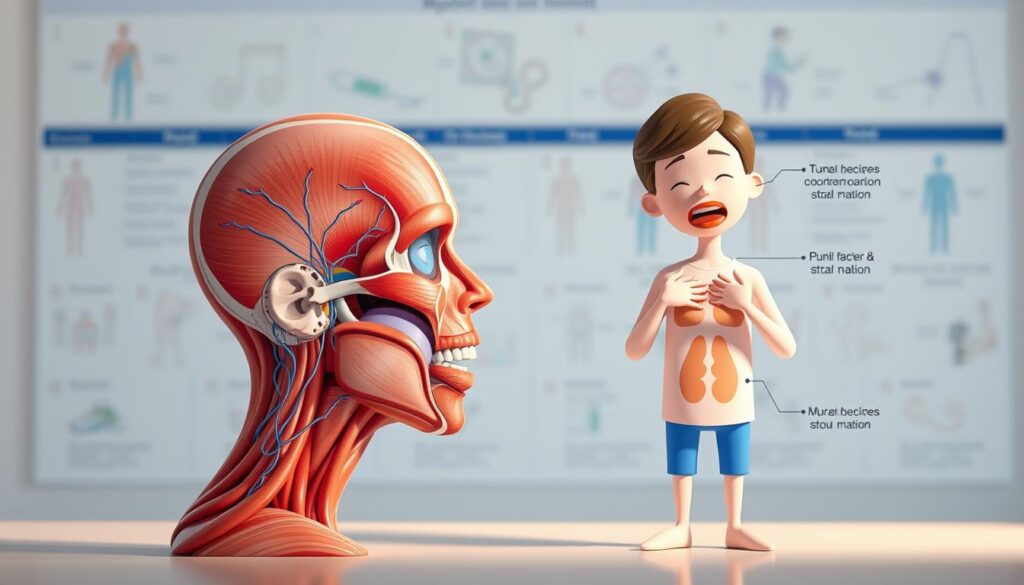Myofunctional therapy has gained popularity as a treatment for various oral and facial muscle dysfunctions.
This therapy involves exercises and techniques to correct issues such as speech disorders, sleep apnea, and TMJ disorders, ultimately improving overall health.
As myofunctional therapy becomes more widely accepted, patients are increasingly concerned about the cost and whether their insurance covers this treatment.
The question remains: does insurance typically cover orofacial myofunctional therapy, and what factors influence coverage?
Key Takeaways
- Understanding the concept of myofunctional therapy and its benefits.
- Factors influencing insurance coverage for myofunctional therapy.
- Typical costs associated with myofunctional therapy treatment.
- Navigating insurance options for myofunctional therapy.
- Health benefits of myofunctional therapy.
What Is Myofunctional Therapy and Why It Matters
As a form of physical therapy, myofunctional therapy targets the orofacial complex to treat dysfunction. It is typically performed by a certified professional with specialized training. The therapy involves a thorough assessment of the individual’s oral and facial muscle function, followed by a personalized treatment plan.

Understanding Orofacial Myofunctional Disorders (OMDs)
Orofacial Myofunctional Disorders (OMDs) refer to conditions that affect the proper function and development of the face and mouth muscles. These disorders can manifest as improper tongue positioning, incorrect swallowing patterns, and mouth breathing.
Common Conditions Treated with Myofunctional Therapy
Myofunctional therapy is used to treat various conditions, including tongue thrust, tongue ties, functional airway obstruction, mouth breathing, TMJ disorders, sleep apnea, speech impediments, and orthodontic relapse. By addressing the root causes of these issues, therapy can improve overall health and quality of life.
The Benefits of Myofunctional Therapy
By addressing orofacial myofunctional disorders, myofunctional therapy provides numerous benefits that enhance overall well-being. This therapy is not limited to a specific age group; instead, it offers advantages across various stages of life.
Benefits for Children
Myofunctional therapy in children can lead to correct craniofacial growth and airway development. It improves sleep quality, which in turn can enhance behavior and school performance. Additionally, it helps stop bedwetting, snoring, sleepwalking, and night terrors. There’s also a reduction in dental decay due to an increased willingness to try new foods, potentially eliminating the need for orthodontics.
Benefits for Teenagers and Adults
For teenagers and adults, myofunctional therapy improves nasal breathing and sleep quality, potentially increasing energy levels. It can also improve or eliminate TMJ pain, reduce sleep apnea events, and decrease bruxism. Furthermore, it enhances periodontal stability of teeth and improves the ease of swallowing, reducing muscle tension in the head and neck.
Long-Term Health Outcomes
The long-term benefits of myofunctional therapy include improved overall respiratory function and better sleep quality. It can lead to enhanced facial aesthetics and proper dental alignment, preventing more serious health conditions like sleep apnea. By addressing orofacial myofunctional disorders early, individuals can prevent the need for more invasive treatments later in life, ultimately improving their quality of life.

Is Myofunctional Therapy Covered by Insurance?
Myofunctional therapy’s insurance coverage is not straightforward and varies significantly across different insurance plans. The extent of coverage depends on several factors, making it essential to understand the specifics of your insurance policy.
Insurance coverage for myofunctional therapy is not a simple yes or no answer. It requires an examination of the insurance provider’s policies, the specific plan, and the condition being treated.

Factors That Determine Insurance Coverage
Several key factors influence whether myofunctional therapy is covered by insurance. These include the insurance provider’s policies, the type of plan, the diagnosed condition being treated, and whether the therapy is administered by a medical or dental professional. For instance, some insurance policies may classify myofunctional therapy as an alternative or complementary therapy, potentially leading to limited coverage or exclusion.
As noted by experts, “Insurance coverage for myofunctional therapy largely depends on the provider and the specific circumstances of the treatment.” This highlights the importance of understanding the nuances of your insurance plan.
Medical Necessity Requirements
Insurance companies typically require documentation that myofunctional therapy is medically necessary to treat a diagnosed condition. Having the therapy prescribed by a physician and linked to a specific diagnosis code can increase the likelihood of coverage. It’s also worth noting that coverage may be partial, with patients responsible for copays, deductibles, or a percentage of the total cost.
To maximize coverage, it’s crucial to work with a healthcare provider who can provide the necessary documentation and support. This can make a significant difference in whether your insurance covers myofunctional therapy.
How to Check If Your Insurance Covers Myofunctional Therapy
Determining whether your insurance covers myofunctional therapy can be a straightforward process if you follow the right steps. To start, it’s essential to understand the process and the information required to make an informed decision about your coverage.
Contacting Your Insurance Provider
The first step is to contact your insurance provider directly. When you call, be prepared to provide your policy number, the specific diagnosis related to your need for myofunctional therapy, such as sleep apnea or speech difficulties, and the credentials of the provider you plan to see. Using specific terminology, such as “orofacial myofunctional therapy,” can help ensure you’re getting the right information. As myofunctional therapy is a specialized treatment, it’s crucial to ask about coverage for this specific therapy.
Obtaining a Letter of Medical Necessity
To support your case for coverage, you may need to obtain a letter of medical necessity from your healthcare provider or the myofunctional therapist. This letter should explain why myofunctional therapy is essential for addressing your condition and its associated health risks. The letter should clearly connect your symptoms to a diagnosed condition and justify why myofunctional therapy is the appropriate treatment.
Exploring Alternative Coverage Options
If your insurance provider does not cover myofunctional therapy, you can explore alternative coverage options. These may include secondary insurance, flexible spending accounts (FSAs), or health savings accounts (HSAs). These alternatives may offer coverage or allow you to use pre-tax dollars to pay for the therapy. It’s also worth asking about partial coverage options or in-network providers who offer myofunctional therapy at reduced rates.

Out-of-Pocket Costs and Financial Considerations
Out-of-pocket costs for myofunctional therapy can vary widely based on several factors, including the provider’s credentials and treatment duration.
Typical Cost Range
The fees for myofunctional therapy can range significantly based on factors such as the professional’s qualifications, geographic location, and the duration of the treatment required. A comprehensive treatment program typically involves multiple sessions over several months, with costs reflecting this extended treatment timeline.
- Initial assessment fees
- Individual therapy session costs
- Follow-up appointment charges
- Any necessary specialized equipment or materials
Long-Term Savings
Investing in myofunctional therapy can lead to significant long-term savings by addressing underlying orofacial myofunctional disorders early, potentially preventing more serious health issues later. This therapy can help prevent costly treatments for conditions like sleep apnea, orthodontic relapse, speech therapy, and TMJ disorders.

Conclusion
Myofunctional therapy provides a holistic approach to improving oral health and overall well-being. By addressing orofacial myofunctional disorders (OMDs), it enhances breathing, sleep quality, and oral function. While insurance coverage varies, patients can explore multiple options for managing costs. It’s essential to advocate for coverage by obtaining proper documentation and working closely with healthcare providers. I encourage readers to consider the long-term health benefits and potential cost savings. Consulting with healthcare providers and insurance representatives can help develop a personalized plan. Take control of your health by making informed decisions about myofunctional therapy.
